This post is about the Columbia River Highway but I want to start by sharing information about the RV park where I stayed as requested by readers. I found an RV park just off the Columbia River Highway which was convenient despite the fact I wasn’t a big fan of the park itself.
Where I Stayed
The biggest challenge about my visit to Portland was finding a place to stay. In my case, it was so close to the wire, I almost didn’t go to Portland. The problem wasn’t lack of RV parks. The problem was that nearly all of them I contacted were booked plus had a wait list or were unreasonably expensive.
At the last minute—and though it wasn’t my first choice—I ended up at Portland Fairview RV Park in Fairview, about 15 miles from downtown Portland. I liked that it was close to Portland and that my friends were also staying there. Still, it was overpriced (or over the price I’m used to paying for a month’s stay) but, I admit, was in the middle price-wise of other places I looked at.
People live in RV parks. I’ve found this to be true everywhere I have stayed, except places with limits such as State Parks. But the Portland area has so many permanent park residents that it is actually hard to find a spot. I’m not sure if they are seasonal workers or people looking to live less expensively because of the high cost of housing in Portland. As a traveler, it made visiting Portland difficult.
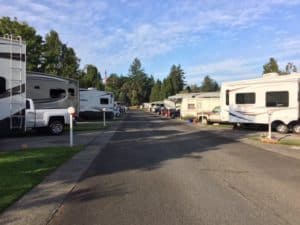
The RV park had a lot of negative reviews which made me nervous but I wanted to visit the area and couldn’t find another option. Most of the bad reviews were justified. And I added my own lengthy negative review once I left. The park itself actually isn’t bad with decent laundry and bathhouse facilities. RVs are close together but there is a little grass patch between each.
My biggest beef with them was their deception in the cost. It came with “hidden” costs. I wrote my review on Campendium (my go-to site for reviews of places to park the RV). Here’s an excerpt:
Fairview advertises a monthly rate of $645 but it is a lie. Once you get here, you learn they add on $50 for water and trash. Then another $75 for electric. Then another $50 for taxes. Plus another $30 because all monthly rentals require a background check. After a week, when the background check was complete, I had to go back to the office to sign a 6 page lease agreement. Took 15 minutes to complete it and I had to have proof of insurance. It was absolutely ridiculous for a 30-day stay.
I gave it one star out of five and would not stay there again. But a bad RV park didn’t keep me from awesome adventures and trips into the city.
Troutdale
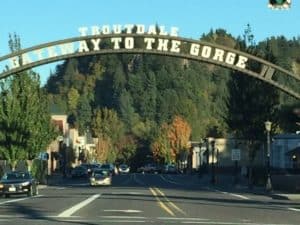
Historic Columbia River Highway was the first highway in US built as a scenic highway. Opened in 1915, the highway was built around nature rather than through nature. The 75-mile European-style road traced a winding path through the Columbia River Gorge. From the time it opened, it acquired the moniker King of Roads.
In Troutdale (which was less than 10 minutes from the RV park), I visited the Columbia River Highway Exhibit. It’s on the main street and easy to spot as it’s in a big red barn. The exhibit is filled with information about the highway from the original vision to the building of it, from its successor to the efforts to restore parts of the original road.
The road, designed for Model T and their contemporaries, was quickly outpaced by the need for larger faster transportation and by the late 1950s a new highway had been constructed.
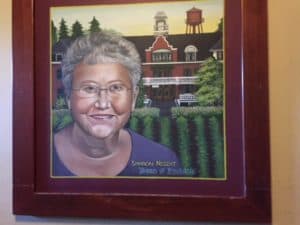
But, the best part of the exhibit was meeting Sharon, the volunteer staff person on the day I visited. Sharon, it turned out, has been the Troutdale’s town historian for the last 50 years. She is as sassy as she is knowledgeable. And, in fact, when we went to dinner at a restaurant (a former poor farm) that displays local artists, I found a painting of her titled, “Queen of Troutdale.” You couldn’t ask for a better town ambassador. Or, should I say, the town couldn’t ask for a better town ambassador. I just love meeting people who adore their town.
When the historic road open, tourists flooded the area and businesses cropped up to meet their needs, everything from gas stations to restaurants. Troutdale was one such area. Troutdale is no longer a must-stop along the highway but it is a quaint little town. There’s an RV park that I would’ve loved to stay at in Troutdale. The RV park had a 9 month waiting list so it wasn’t an option. But it sure would’ve been awesome to leave the RV park and walk to the small downtown main street.
I loved Troutdale as much as Portland.
Wondering about the name? Sharon told me the story. Captain John Harrow, the founder of Troutdale, sold his house to his brother, Fred, because he’d run into some financial issues. His brother dug some ponds and started growing carp with the idea to sell them to local restaurants.
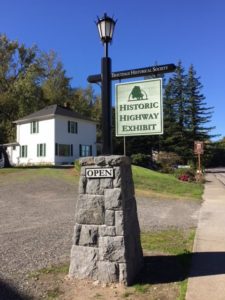
The sign for the Columbia River Highway exhibit with the Harrow House in the background. It’s on the other side of the house where the carp / trout ponds were.
But then the Columbia flooded (which is does about every 60 years) and washed away the carp. The same flood that took carp out of the ponds brought trout into the ponds. So, the story goes. It’s such a good story that Sharon titled her book on 100 years of the town history (1907 – 2007), “It Could Have Been Carpdale.”
Next door to the red barn you’ll find the Fred Harrow House, built in 1900. Today it serves as a museum run by the Historical Society. It’s also worth a visit.

Statue of the first woman mayor of Troutdale.
Captain Harrow’s daughter became the mayor of Troutdale in 1924. And she wasn’t the first woman mayor. Clara Latourell Larsson was the first in 1914. In the town square and throughout the downtown area are historical statues. It’s a treasure hunt to find them. In the town square, Clara stands holding the Troutdale paper. The paper is readable and you’ll see an article about Clara herself. That made me laugh.
Vista House

If you are in the area, in addition to visiting Troutdale, stop at Vista House at the Crown Point State Park. It was designed to “grace the highest spot on that wonderway,” as described in The Oregonian at the time. The rocky promontory is nearly 700 feet above the Columbia River and offers vast views of the area.

As I said, the road was built to feature the natural beauty and Crown Point is one such example. The road curves around the natural feature of Crown Point rather than through the area. Sharon said it was styled to mimic the brim of a man’s hat. Vista House at Crown Point was the first “comfort station” because, as Sharon so eloquently stated, “ladies out for a drive had to whiz.”
Vista House was designed by the architect Edgar M. Lazarus and he designed the building to be “a temple to the natural beauty of the Gorge.” And it is a temple. The first time I saw a photo, I thought it was a religious house rather than a welcome center. In 1974, Vista House was listed on the register of Historic Places.
It was fun to read the informational signs. The Vista House, because of cost, was quite controversial in its day. Lucky for us, it was built and we can still visit it, whether you go to “whiz” or to enjoy the view.
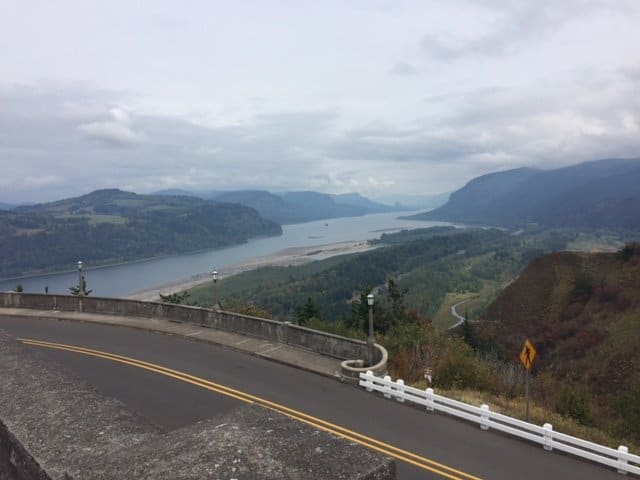
We went on a cloudy day so the photos aren’t as crisp and clear as they would be on a gorgeous day. No matter what the weather is doing, you cannot fail to awe at the beauty of the Vista House, the vistas and the vision more than 100 years ago that resulted in such an awesome place.
Two Funny Stories
First story. Completed in 1916, one of the bridges of the highway, Eagle Creek Bridge, featured arch masonry rail and a viewpoint. Nearby, the Eagle Creek Campground became the first US Forest Service campground in the country. It was so “modern” it included the first flush toilet installed by the Forest Service, affectionately called “Big John.”
Second story. In addition to being the first scenic highway, Columbia River Highway also has the distinction of having the first white line painted down the center. As Sharon tells it, the road was 20 feet wide and the sheriff at the time declared it much too wide. Convinced two people were going to hit each other, he decided a line down the middle separating traffic would help.
So they hired a man to paint a center line. He did it with a bucket of white paint and a four-inch wide paintbrush. A hazardous job you might be thinking. He survived the job though not without incident. Sharon says, “He was hit in the ass by a car but it only dented his Skoal can.”
What’s the most scenic highway you’ve ever driven? No doubt there are many to choose from. Still, I find the Turnagain Arm in Alaska the most beautiful, but Columbia River Highway is a close second. At least for now. I have a lot more still to see so stay tuned as I reserve the right to revise my opinion.
Other Posts About Portland:
To see products recently purchased by readers or to browse and shop at Amazon, follow either of these links. As an Amazon Affiliate, I earn from qualifying purchases. Huge thanks for your support.
- Instant Pot (I know I’ve posted this before but another reader bought one recently.)





Hey Debbie! Sorry to hear about your rough week! This post is really good though, and I enjoyed it a lot. I had the same problem finding an RV spot in Portland. Happy travels! Rhonda
Ps. I hope Solstice is doing well.
Thanks, Rhonda. I’m glad to know I’m not the only one who found Portland difficult. Maybe it is somewhat common, but it was certainly a first for me. I’m not sure if it is Portland specifically, or if larger cities all have a similar issues with lack of sites and higher costs. Happy travels to you as well. Hope you are getting settled in the new spot.
I really enjoyed driving down US Hwy 101 from Washington through California and all the amazing places to stop along the way. Be well. Love, Marie
So many places. I’m thinking of a 3-4 month trip just to do the Oregon part of Hwy 101 in the future. It would be great to be able to stop at ever little cool place you see along the way.